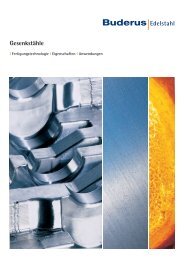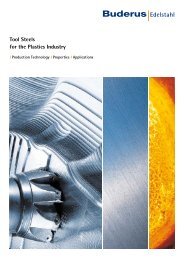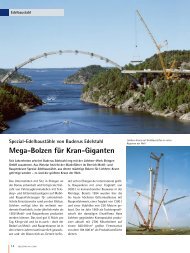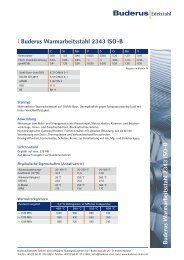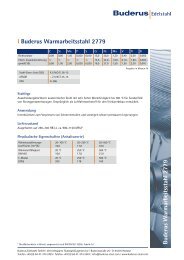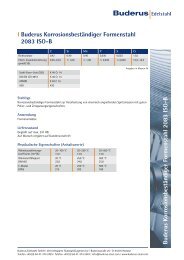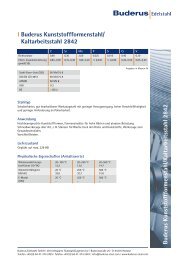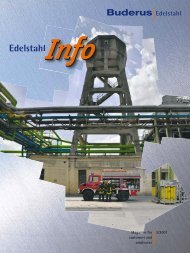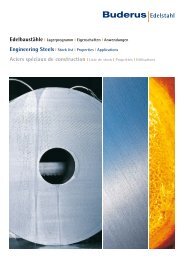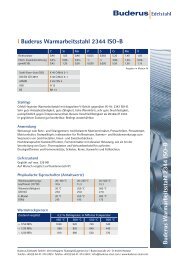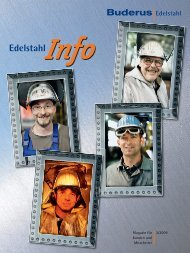Die Steels - Buderus Edelstahl Gmbh
Die Steels - Buderus Edelstahl Gmbh
Die Steels - Buderus Edelstahl Gmbh
You also want an ePaper? Increase the reach of your titles
YUMPU automatically turns print PDFs into web optimized ePapers that Google loves.
The material concept<br />
The right material for all<br />
application profiles<br />
Optimal use of a die steel is closely linked to understanding its stress<br />
profile (Figure 1). The right die steel for forging-die and press-die<br />
units and secondary tools is selected bearing in mind economic<br />
and qualitative aspects. One major factor is the die’s service life<br />
or estimated tool life quantity (see Tables 1 and on page 8). The<br />
tool life quantity is generally limited by wear, or by cracking in the<br />
case of complicated impressions (see Table 1 on page 8+9).<br />
<strong>Die</strong> wear is significantly reduced as the alloy content of carbide<br />
formers such as vanadium, molybdenum, tungsten and chromium<br />
is increased, as shown in Figure . One qualitative measure of this<br />
is the alloy coefficient (AC) used to rate steel. Higher-grade steels<br />
produce favourable results when an optimum relationship between<br />
tool life quantity and tool costs is achieved.<br />
The tool life quantity can be further optimized by increasing hardness,<br />
balanced with the necessary toughness characteristics. Key<br />
here is uniform quenching and tempering of the dies throughout<br />
their cross-section. Comparing the hardness distribution of the<br />
standard die steel 2714 ISO-B to the recently developed new die<br />
steel 2714ISO-Bmod. confirms this modified composition improves<br />
hardening and tempering characteristics (see Figure and Table<br />
on page 10).<br />
Figure 1<br />
<strong>Die</strong> tool stress profile<br />
Mechanical<br />
stress<br />
Thermal<br />
stress<br />
Mechanically induced<br />
state of tension<br />
Mechanical die load<br />
Relative movement<br />
die/forging<br />
Deformation • Cracking • Fracture<br />
Wear • Deformation • Temperature fatigue cracking<br />
Thermally induced<br />
state of tension<br />
Thermal die load<br />
Loss of cohesion<br />
Matched material characteristics<br />
ensure high tool life quantities<br />
This special steel is effective for forging dies with high volumes,<br />
regardless of the die size and impression depth.<br />
Heat resistance and hardness retention are key material indicators<br />
for die steels. Loss of hardness and even transformation of the<br />
microstructure at the impression surface is the most frequent cause<br />
of wear, deformation and cracking.<br />
Figure 2<br />
Effect of alloy content on die wear<br />
<strong>Die</strong> wear (µm)<br />
µm<br />
350<br />
300<br />
250<br />
200<br />
150<br />
100<br />
50<br />
2713<br />
2714<br />
2744<br />
2714mod.<br />
2766<br />
2343<br />
2606<br />
2365<br />
2344<br />
2367<br />
Temperature 250°C<br />
Alloy coefficient<br />
2Cr + 5W + 10Mo + 40V<br />
0<br />
0 10 20 30 40 50 60 70 80 90 100 110 120<br />
Alloy coefficient




